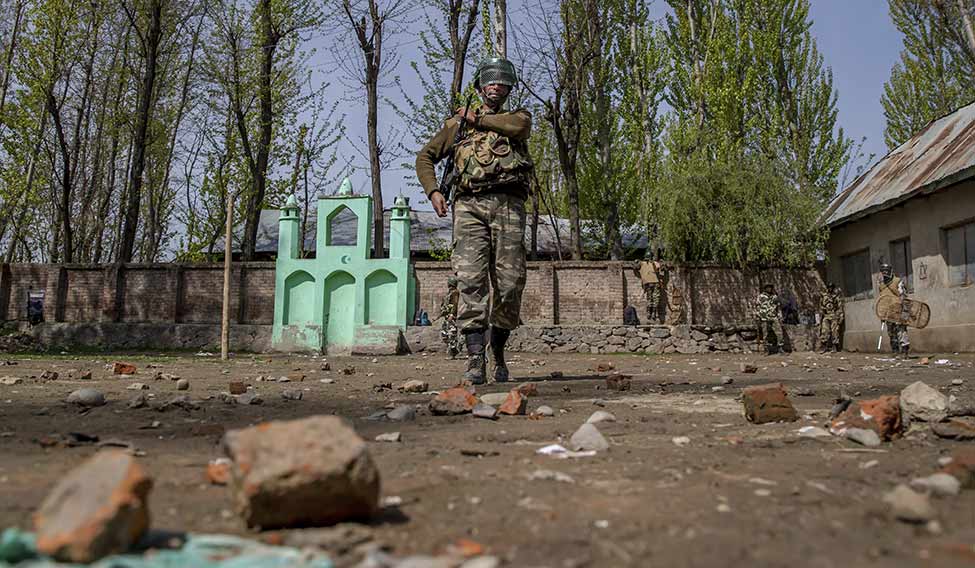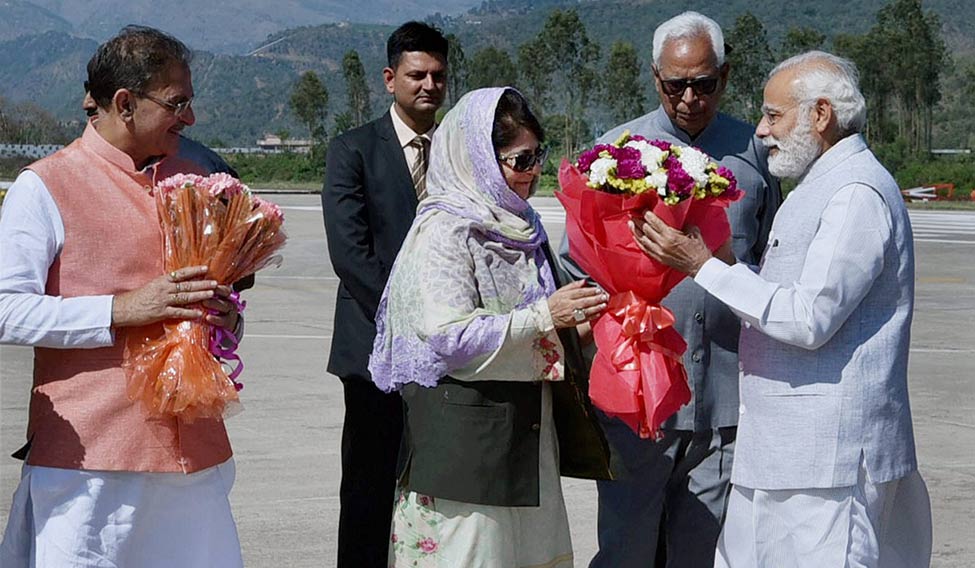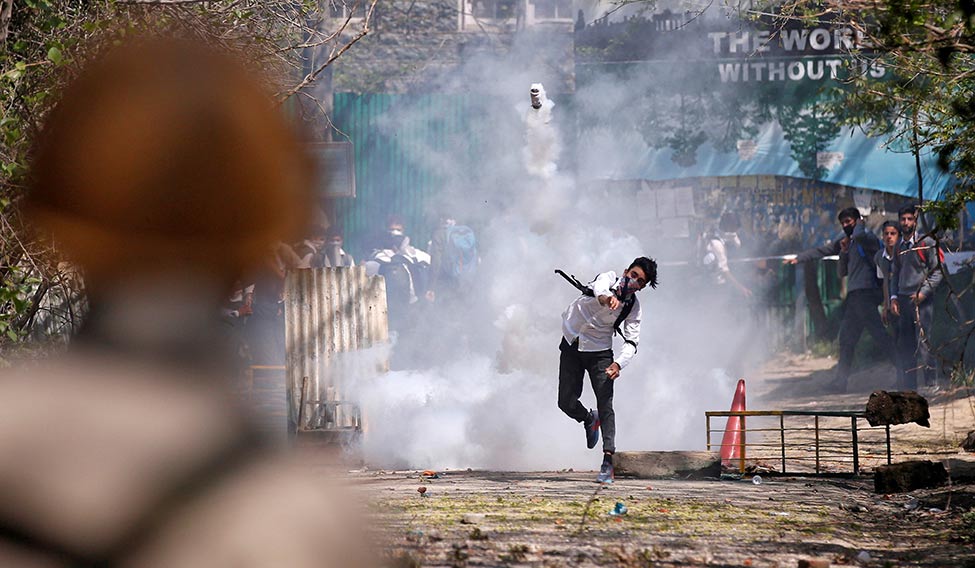On April 10, a day after eight civilians were killed in clashes with security forces during anti-election protests in Srinagar, senior government officials met to discuss how the fallout would affect Anantnag, which would also hold a Lok Sabha byelection two days later. Most of the polling booths in Anantnag—more than 1,500—had been declared hyper sensitive. In the meeting, the officials were told, based on intelligence reports, that violence in Anantnag could kill four to five times more people than in Srinagar. “The meeting felt it would be impossible to protect the polling booths from mobs without the use of massive force,” a senior official who attended the meeting told THE WEEK. A minister had suggested relocating some of the booths to “safer” places, but “we thought that would be tantamount to premeditated rigging,” said the official. The Election Commission and the opposition would not allow that to happen, the official said. It was then that Tassaduq Hussain Mufti—the Peoples Democratic Party candidate in Anantnag and brother of Chief Minister Mehbooba Mufti—asked the commission to postpone the elections.
Most political analysts said Tassaduq had done so for fear of losing. Like in Srinagar, where only 7.14 per cent of the electorate voted, a low turnout in Anantnag could have tipped the scale in favour of G.A. Mir, the Congress candidate supported by the National Conference. Mir, furious with the deferral, said if the situation was so bad, Mehbooba should have immediately resigned.
The PDP, said sources, would prefer to contest the elections this winter—the harsh weather would reduce violence and Tassaduq would have more time to gather support. Many observers, however, said the situation in Kashmir had worsened to such an extent that ensuring greater participation in elections would need a lot of work. Interestingly, just three years ago, in the 2014 assembly elections, the voter turnout had been 66 per cent.
The separatist sentiment, which survived despite a crushing defeat in the 1990s, has now manifested itself in street protests and stone pelting. The protesters are the youth of Kashmir, aged 16 to 24 and raised during the unstable years of militancy. Hizbul Mujahideen commander Burhan Wani, whose killing in 2016 sparked violent uprisings in Kashmir, was part of this generation.
 Bye elections: Paramilitary personnel at a polling station in Srinagar. The turnout for the Lok Sabha byelection on April 10 was 7.14 per cent | AP
Bye elections: Paramilitary personnel at a polling station in Srinagar. The turnout for the Lok Sabha byelection on April 10 was 7.14 per cent | AP
A major reason for the unrest in Kashmir is the shrinking of the middle ground that the PDP had created. It was seen as an alternative to the decades-long rule of the NC and seemed to support “soft separatism”. The stand on separatism won the party the support of some militants and their supporters in Pakistan. The PDP occupied the space between the NC and an uninspiring Hurriyat Conference. The emergence of the PDP not only robbed the separatists of their agenda, but also lent credence to the otherwise sham democracy in Kashmir. The PDP’s rise—it formed government in 2002—was aided by Pakistan’s peace overtures to India. “Post 9/11, especially between 2003 and 2006, the infiltration completely dried up on the Line of Control,” said a senior intelligence officer of the Jammu and Kashmir Police. “The PDP claimed it had brought peace to Kashmir.”
But the calm ended in 2008, when the Congress government, supported by the PDP, transferred 99 acres to the Sri Amarnathji Shrine Board. There were demonstrations against the move and some people were killed. Two years later, the Army killed three civilians in a fake encounter at Machil in Kupwara. The protests that followed morphed into a separatist uprising and nearly dislodged the Omar Abdullah-led NC-Congress government.
This was when Burhan, a teenager, fled home and joined the Hizbul Mujahideen to avenge the “humiliation” caused by the security forces. From 2010 to 2016, he operated in the PDP’s political base and enticed hundreds of youngsters. He began posting pictures and videos on social media, glorifying his battle, and soon became the poster boy of militancy in Kashmir. “He did not hide behind a mask and he made it look like fun,” said the officer. Militancy regained social acceptance and Islam once again became the motivation for taking up arms. Shahadat (martyrdom) became a goal for many.
“Today’s militants consider surrendering a sin, unlike those of the previous generation. This also stems from Islam,” said Khalid Gul, a south Kashmir-based senior journalist and analyst. Recently, when a Hizbul militant was arrested from hospital, there were reports that he had surrendered. His supporters, however, strongly rebutted that claim on social media.
Since February 17 civilians, mostly boys, have been killed in clashes between security forces and stone pelters. Such has been the intensity of the protests that polling could not be held in 10 per cent of the polling booths in Srinagar. Mobs ransacked polling booths, damaged electronic voting machines and set ablaze vehicles used by the polling staff. Only 2 per cent of the voters showed up for re-polling in some booths; 28 of 38 booths recorded zero per cent turnout. This despite the deployment of 17,000 police and paramilitary troops for 35,000 voters. A day before the election, the state government had shut down the internet, hoping to curtail the violence. However, eight people were killed in anti-election protests.
 Mehbooba has faced a lot of flak from Kashmiris for her alliance with Modi | PTI
Mehbooba has faced a lot of flak from Kashmiris for her alliance with Modi | PTI
After the internet was restored, videos of security forces torturing civilians went viral on social media, including one of Farooq Ahmad Dar, 26, who was used as a human shield by the Army. It further inflamed passions and put pressure on the PDP-BJP government. Dar, a shawl artisan from Budgam, and one of the few residents who voted in the Srinagar byelection, was strapped to the bonnet of a jeep and was driven through villages for 27 kilometres.
“I was on my bike, going for the condolence ceremony of a relative at Gampora in Pulwama, when the Army stopped me at Utligam and thrashed me,” Dar told THE WEEK. “Then I was made to sit on a tyre on the front bumper and tied with a rope.” A soldier was seen daring pelters to throw stones at the jeep. Dar was released after the sarpanch of his village, Chil, asked the Army to let him go. “The Army took away my phone and broke my arm,” he said. “I don’t want to register a complaint as I have an old mother to look after.” The act was widely condemned on social media and rights groups such as Amnesty International demanded an inquiry.
Such developments have put a lot of pressure on the PDP leadership, especially on Mehbooba. There has been criticism within the party, too. Party leader Javid Mustafa, for instance, blamed Mehbooba for the killing of three youths during an encounter on April 3 at Chadoora in Budgam. “As home minister, Mehbooba should take the blame for what has happened,” he said. “It is unacceptable that our boys are shot dead during protests.”
Said PDP spokesman and influential youth leader Waheed Para: “The youth have a right to protest, but it has to be meaningful and peaceful. They have to become stakeholders in peace. Peace cannot be enforced and should not be security driven. But when you wave an Islamic State or Pakistan flag, it becomes a red rag. I think we need to be cautious that democracy doesn’t alienate people.”
The unrest among the youth was fuelled by the PDP’s alliance with the BJP after the assembly elections in 2014. The pro-separatist constituency, which had supported the PDP, was outraged by this partnership. Qasim Sajad, who was an independent candidate in the 1987 assembly elections, said the party had betrayed the people of Kashmir, especially its cadre. “The political clout the PDP had gained has been seriously dented,” said Sajad. “Kashmiris will never support an alliance with the BJP.”
An aide of Mehbooba told THE WEEK that the party had hoped that the BJP-led Union government would fund development projects and come to the aid of the victims of the 2014 floods. “Nothing has happened. Instead, the Centre has used the PDP to execute its own agenda in Kashmir,” said the aide. “I accept that the plan to build sainik colonies, pandit colonies and settling outsiders in Kashmir has vitiated the atmosphere in Kashmir. Mehbooba resisted the formation of the government for 40 days, but she was compelled after the BJP encouraged a quiet coup in the party.”
When Mufti Mohammad Sayeed, after becoming chief minister in 2014, urged the Centre to reach out to Pakistan to improve the situation in Kashmir, he was publicly snubbed by Prime Minister Narendra Modi. “I don’t need advice from anybody on Kashmir,” Modi had said at a rally.
Siddiq Wahid, vice chancellor of the Islamic University of Science and Technology in Kashmir, said Modi’s speech was a “direct message” to Mufti to limit his politics to development. Analysts in Kashmir said the BJP was now using strong-handed tactics to deal with Kashmir so as to polarise the rest of India. The surgical strikes in Pakistan-occupied Kashmir were part of that plan, and helped the BJP win the assembly elections in Uttar Pradesh. Many experts said they believed this would continue till the 2019 Lok Sabha elections.
 Rough ride: Farooq Ahmad Dar, who was tied to a jeep by the Army, at home with his mother | Umer Asif
Rough ride: Farooq Ahmad Dar, who was tied to a jeep by the Army, at home with his mother | Umer Asif
The BJP’s moves have further broken the political middle ground, creating extreme positions and generating hostility towards mainstream politics and security forces. Young boys are now risking their lives for trapped militants and students are protesting at the slightest provocation. On April 14, clashes with security forces in a college in Pulwama, south Kashmir, left 50 students injured. On April 18, hundreds of students took to the streets to protest the high-handedness of the police at the college. Several students and policemen were injured.
Such is the tension that Sheesh Pal Vaid, the Jammu and Kashmir director general of police, recently issued an advisory, asking policemen, especially those from south Kashmir, to avoid visiting their hometowns for the next few months. “What is wrong if the head of the family tells his members to take care?” Vaid asked THE WEEK. “Please don’t give it too much publicity.”
Two policemen THE WEEK spoke to said the advisory was unneeded. “This has brought unnecessary focus on us,” one of them said. “Now we will be tracked both by the militants and the Army unit. What is this?” asked the other.







